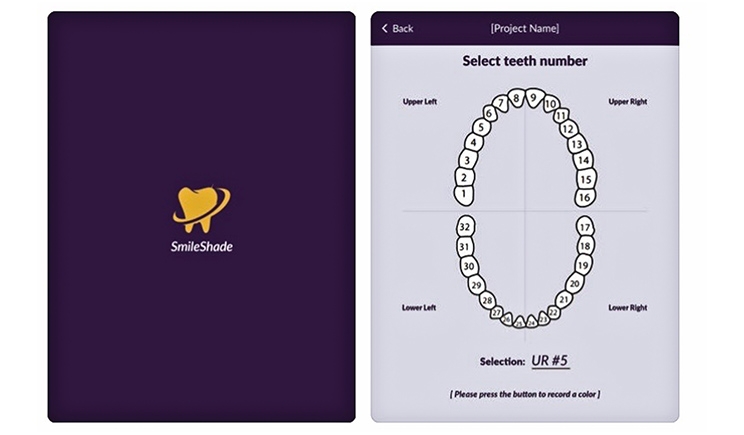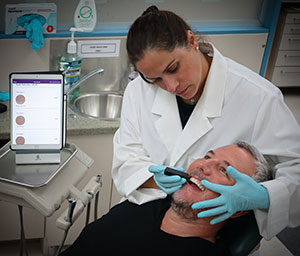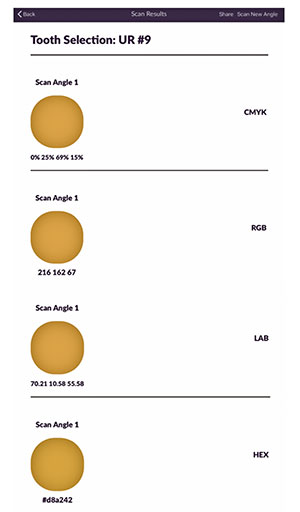
Determining the shade of dental materials is a challenging requirement for the restorative dentist1. From simple tooth-colored fillings to ceramic crowns, the correct shade needs to be determined and communicated to the dental laboratory for the successful delivery of treatment2.
Based on the numerous variables associated with shade selection, such as the light source, the tooth, the eye, and retinal fatigue, shade determination may prove to be challenging even for the experienced clinician2,3. Moreover, shade selection presents a difficult endeavor for the dental student,4 with a success rate of 49%5.
Improper shade selection is the second most common cause of laboratory remakes6, resulting in inefficiency and additional cost, as well as unnecessary stress for the clinician and patient.
The process of shade selection is rather subjective, with no consensus on protocol2. Instrumentation has been developed to assist with the procedure, with limited success, variability in results, and cost hindrance7,8. In addition, shade selection has focused on tooth color, with little to no investigation into the pink shade selection to mimic the soft tissues9.
The aim of this research investigation was to develop a novel software application, coupled with peripherals, to provide an accurate, objective, and systematic approach to shade determination for teeth, soft tissues, and dental materials. The research is an extension of technology that has been used in photography and cinematography, with a specific dental application that provides a predictable and successful workflow.
Materials and Methods
An iOS software application called Smile Shade was developed (Figure 1) to facilitate a simple, accurate, and systematic approach for dental shade determination. It wirelessly pairs with a color scanning device and provides a seamless and stepwise workflow for the determination of dental shade.
 |
 |
|
Figure 2. The operator places the scanner on the surface that requires shade determination and presses the scan button on the device. |
Figure 3. The device requires approximately 2 seconds to generate a color determination of the material, and then the application creates a multiple-screen display of the color. |
The application is only compatible with Apple’s iPad. It is free to download, but it requires a color scanning device for operation. The device is available through the app by selecting the “I don’t have a device” icon.
Once the app has been downloaded, the operator opens it and pairs it with the device through a wireless Bluetooth connection. The operator then selects the tooth number requested for scanning. Next, the operator places the scanner on the surface that requires shade determination and presses the scan button on the device (Figure 2). The device requires approximately 2 seconds to generate a color determination of the material, and then the application creates a multiple-screen display of the color (Figure 3).
The operator may add a project name and appropriate notes and save the shade, or the file may be deleted. The file is stored on iCloud and may be downloaded or emailed for communication.
Smile Shade functions on a high-dynamic-range micro-color sensor with an automatic temperature control and an inter-device repeatability of less than 1.0 ∆ E. The determination of shade is completed through the evaluation of color based on CMYK, RGB, and LAB, which are different techniques of storing colors.
CMYK represents cyan, magenta, yellow, and key (black)10. By using these colors, many other colors may be created. CMYK is typically used for tangible work, such as printing, and is considered “light” in nature10.
RGB represents red, green, and blue. Different colors can be created by adding many small pixels of red, green, and blue together10. RGB is typically used to display digital work and is considered an industry standard for storing color data digitally10.
LAB represents L for lightness and A and B for the color dimensions (green and red, blue and yellow)11,12. The LAB color space is the most exact means of representation. This accuracy and portability suit it for a number of different industries such as print, automotive, textiles, and plastics.
Although the LAB color is the most exacting, it is not the most common. LAB color is usually converted to less accurate color, such as RGB and CMYK, as computer monitors and printers use either three or four colors to represent images12.
HEX was also included in the shade determination and is a syntax to encode the colors using hexadecimal values13. The hex values may be used to code for RGB, CMYK, and LAB13.
Discussion
The Smile Shade application was developed to provide a simple, systematic, and objective workflow for the determination of shade. The second part of the research investigation is currently underway to compare this novel application to the traditional shade tab approach commonly practiced at most dental schools. The data from the investigation will be available for publication in the late fall.
This novel approach to shade determination offers clinicians an alternative digital dentistry tool, with the aim of providing simplicity and accuracy and a reduction in errors and remakes.
References
- Fondriest J. Shade matching in restorative dentistry: the science and strategies. Int J Periodontics Restorative Dent. 2003;23:467-479
- Ahmad S, Habib SR, Azad AA. Scientific and artistic principles of tooth shade selection: a review. Pakistan Oral & Dental Journal. 2011;31:222-226.
- Chu SJ, Mieleszko AJ. Color-matching strategies for non-vital discolored teeth: part 1. Laboratory ceramic veneer fabrication solutions. J Esthet Restor Dent. 2014;26:240-246
- Alsaleh S, Labban M, AlHariri M, et al. Evaluation of self shade matching ability of dental students using visual and instrumental means. J Dent. 2012;40(suppl 1):e82-e87.
- Jaju RA, Nagai S, Karimbux N, et al. Evaluating tooth color matching ability of dental students. J Dent Educ. 2010;74:1002-1010
- McLaren EA. Bonded functional esthetic prototype: an alternative pre-treatment mock-up technique and cost-effective medium-term esthetic solution. Compend Contin Educ Dent. 2013;34:596-607.
- Chu SJ, Trushkowsky RD, Paravina RD. Dental colour matching instruments and systems. Review of clinical and research aspects. J Dent. 2010;38(suppl 2):e2-e16.
- AlGhazali N, Burnside G, Smith RW, et al. Performance assessment of Vita Easy Shade spectrophotometer on colour measurement of aesthetic dental materials. Eur J Prosthodont Restor Dent. 2011;19:168-174.
- Kahng LS. Chameleon qualities: how to mimic natural tissue colour in the connective gingival. Dental Lab Products. November 2010:36-37.
- Barron BS. RGB vs. CMYK: A guide to color systems for designers. Envato Blog. February 13, 2017. https://envato.com/blog/rgb-vs-cmyk-guide-color-systems-designers/ Accessed October 22, 2019.
- Paul S, Peter A, Pietrobon N, et al. Visual and spectrophotometric shade analysis of human teeth. J Dent Res. 2002;81:578-582.
- Representing color with the Lab color space. https://www.mathworks.com/discovery/lab-color.html Accessed October 22, 2019.
- Woodhead P. The surprising science behind colour codes. https://medium.com/pilcro/the-surprising-science-behind-colour-codes-6664c6f3b8a3 Accessed October 22, 2019.
Dr. Kalman is an assistant professor of restorative dentistry and outreach coordinator at the Schulich School of Medicine & Dentistry at Western University. His research focuses on translatable medical devices and technologies. He has published more than 40 articles and has patented and translated several technologies, and he is actively involved with the regulatory aspects of dentistry. He is a member of the SCC and serves on the boards of directors for UWOFA and CAPHD. He has been recognized as an Academic Associate Fellow, Fellow, Master and Diplomate (ICOI), and Fellow (AO). And, he has been named to the Schulich Alumni of Distinction and has received the Merck Patients First Award. More information can be found at schulich.uwo.ca/dentistry/research/kalman_lab_research.html.
Related Articles
App Matches Shades on Your Smart Phone
Diagnosis by Smartphone? There’s an App for That
App Helps Patients Assess Their Own Oral Health











